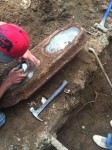 Last year, construction workers digging underneath a garage in San Francisco unearthed a child’s coffin. The bronze casket was three-and-a-half feet long and had two leaded glass windows, a popular design in the Victorian era for those who could afford it. Through the windows the well-preserved body of a little girl could be seen. She was wearing a white lace christening dress and ankle high shoes. She was also wearing a long necklace and holding a single flower which was at first believed to be a rose, but later found to be a purple nightshade flower. Little purple flowers had been woven into her hair and roses, baby’s breath and eucalyptus leaves were placed around her body.
Last year, construction workers digging underneath a garage in San Francisco unearthed a child’s coffin. The bronze casket was three-and-a-half feet long and had two leaded glass windows, a popular design in the Victorian era for those who could afford it. Through the windows the well-preserved body of a little girl could be seen. She was wearing a white lace christening dress and ankle high shoes. She was also wearing a long necklace and holding a single flower which was at first believed to be a rose, but later found to be a purple nightshade flower. Little purple flowers had been woven into her hair and roses, baby’s breath and eucalyptus leaves were placed around her body.
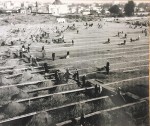 The find was poignant, but not surprising. The home is in the Richmond District, which in the 19th century was the site of multiple cemeteries. When the real estate value of the district outpaced its value as a (not so) eternal resting place in the early 20th century, San Francisco evicted the underground tenants from Richmond and almost every other cemetery within city limits, leaving only two cemeteries of 26 intact. The city claimed this mass exhumation was necessary to prevent the spread of disease, but nobody was fooled. The remains of about 300,000 people were exhumed and reburied south of the city in Colma, which a decade later would be officially founded by cemetery owners as a necropolis that would never be subject to the political considerations that had spurred the liquidation of San Francisco’s graveyards. The little girl was one of 26,000 people buried in the Odd Fellow’s Cemetery, most of whom were moved to Colma’s Greenlawn Memorial Park in around 1920.
The find was poignant, but not surprising. The home is in the Richmond District, which in the 19th century was the site of multiple cemeteries. When the real estate value of the district outpaced its value as a (not so) eternal resting place in the early 20th century, San Francisco evicted the underground tenants from Richmond and almost every other cemetery within city limits, leaving only two cemeteries of 26 intact. The city claimed this mass exhumation was necessary to prevent the spread of disease, but nobody was fooled. The remains of about 300,000 people were exhumed and reburied south of the city in Colma, which a decade later would be officially founded by cemetery owners as a necropolis that would never be subject to the political considerations that had spurred the liquidation of San Francisco’s graveyards. The little girl was one of 26,000 people buried in the Odd Fellow’s Cemetery, most of whom were moved to Colma’s Greenlawn Memorial Park in around 1920.
The medical examiner’s office examined the body in situ, but told homeowner Ericka Karner that it was entirely her responsibility to see to its disposition because the child was found on her property. She looked into reburial options, but the most modest estimate was $7,000. The priciest quote was $22,000. Meanwhile, the casket had been unsealed during the examination and the remains of the child, whom she named Miranda Eve, were beginning to deteriorate.
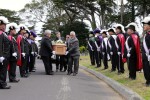 With the body of a little girl decaying in her backyard, Karner called City Hall. They wouldn’t take responsibility for the remains their predecessors had so half-assedly overlooked either, but they did put her in touch with the Garden of Innocence, a non-profit organization that arranges dignified burials for unknown or abandoned children. Elissa Davey, genealogist and founder of Garden of Innocence, raised money and arranged donations for the reburial. A month after she was found, Miranda Eve was reburied in a donated plot in Greenlawn Memorial Park. She was placed in her original bronze coffin, and it was placed inside a new wood casket inspired by the two-window design of the original.
With the body of a little girl decaying in her backyard, Karner called City Hall. They wouldn’t take responsibility for the remains their predecessors had so half-assedly overlooked either, but they did put her in touch with the Garden of Innocence, a non-profit organization that arranges dignified burials for unknown or abandoned children. Elissa Davey, genealogist and founder of Garden of Innocence, raised money and arranged donations for the reburial. A month after she was found, Miranda Eve was reburied in a donated plot in Greenlawn Memorial Park. She was placed in her original bronze coffin, and it was placed inside a new wood casket inspired by the two-window design of the original.
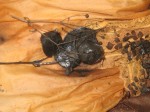 Davey didn’t stop there. She wanted to give Miranda Eve her identity back. The task was monumental. First they were able to discover the manufacturer of the coffin: N. Gray & Co. Undertakers. Then they found a map of the Old Fellow’s Cemetery which they compared with modern street and other maps to pinpoint the location of the burial. It took more than 1,000 hours of research and a year of assiduous work, but the Garden of Innocence team was finally able to discover Miranda Eve’s real name. She was Edith Howard Cook, daughter of Horatio Nelson and Edith Scooffy Cook, who died on October 13th, 1876, when she was less than two months short of her third birthday.
Davey didn’t stop there. She wanted to give Miranda Eve her identity back. The task was monumental. First they were able to discover the manufacturer of the coffin: N. Gray & Co. Undertakers. Then they found a map of the Old Fellow’s Cemetery which they compared with modern street and other maps to pinpoint the location of the burial. It took more than 1,000 hours of research and a year of assiduous work, but the Garden of Innocence team was finally able to discover Miranda Eve’s real name. She was Edith Howard Cook, daughter of Horatio Nelson and Edith Scooffy Cook, who died on October 13th, 1876, when she was less than two months short of her third birthday.
Funeral home records show Edith died from marasmus, or severe undernourishment. It’s not clear what caused the illness, but in late 1800s urban living could have led to an infectious disease, the nonprofit said.
Information released Tuesday reveals that Edith was born into two prominent families in the world of commerce and society. Her mother was born into a San Francisco pioneer family, as her father Peter Scooffy was an original member of the Society of California Pioneers.
Horatio Cook and Edith Scooffy married in 1870 and baby Edith’s father tanned hides and manufactured leather belts. He also served as Consul for Greece.
After her death at a young age, Edith’s parents had another daughter, Ethel Cook, who was declared by a Russian nobleman as the most beautiful woman in America, the nonprofit reported.
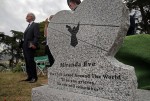 Her identity was confirmed by DNA which was a match with the DNA of Edith’s grand-nephew Peter Cook. The headstone of “Miranda Eve” was left blank on the back so they could engrave her real name on it, should it ever be found. Now that it has, Edith Howard Cook will have her name on her headstone again.
Her identity was confirmed by DNA which was a match with the DNA of Edith’s grand-nephew Peter Cook. The headstone of “Miranda Eve” was left blank on the back so they could engrave her real name on it, should it ever be found. Now that it has, Edith Howard Cook will have her name on her headstone again.
The Garden of Innocence website has uploaded a detailed report of the discovery, reburial and their exceptional research on their website.
Nice story. Requiescat in pace, little Edie.
What happens when, in Philadelphia, Pennsylvania, a burial ground dating to the late 18th century is uncovered by developers? :blankstare:
http://www.philly.com/philly/news/Race-to-dig-at-historic-cemetery-a-mere-hint-of-what-ails-Philadelphias-oversight-of-buried-treasures.html
Requiescat in pace, little Edie. Good story.
Great story Livius and very timely, as these types of shenanigans are still common in the age of suburban sprawl and the scramble for natural resources. I can’t count the number of small cemeteries destroyed under the banner of “mineral rights” due to mountaintop removal coal mining and shale oil and gas drilling in the past twenty-five years here. What’s on or a few feet below the surface doesn’t matter when there is a lot of money involved.
Most of the old cash poor farmers who signed away their mineral rights in the late 19th century were barely literate and couldn’t imagine why anyone would offer them enough to buy a team of mules for what might be under the ground? The current surface owners have no rights under those old agreements. It was a crime now and a crime then.
Ok, as Horatio Cook and Edith Scooffy got married in 1870, Edith Howard Cook was the daughter of Horatio Nelson and Edith Scooffy Cook and she died in 1876, so far (un)fair enough.
However, after 145+ years -i.e. in order to peacefully lay my own soul to rest- May I humbly ask, if the two Horatios are identical and maybe, who that ‘Howard’ is supposed to be ? Moreover, couldn’t ‘Miranda Eve’ add to confusion in the future ?
That is a rather wonderful story, quite touching and something of a tear-jerker. Following your links, on one of the websites they show her beautiful little face photographed through her coffin’s window – in that photo, she looks like she’s simply asleep.
Elissa Davey did a wonderful job with this.
And shame on the city of San Francisco for doing nothing.
I just saw this yesterday! I’m surprised no one has really commented on how well preserved she is? I mean, from that one picture it’s almost unbelievable how lifelike she looks! I googled it and all the articles were basically copies of each other; and none of them said much beyond that she was really well preserved.
Anyways, it’s a sad story. Even though she died so long ago, just the fact that a little child died is enough to make me sad 🙁
@A – read my comment above. 🙂
Rest in pace, little Edie. Good story.
@Vierotchka
I know, I saw your comment 🙂 I meant, none of the articles seem to be expressing surprise at how well preserved she was, or offering an explanation (beyond that the casket was tightly sealed; would that be enough for that level of preservation?).
@A – Far from being an expert, and with no pictures at all, she was -most likely- actively mummified (which -as we all know- does not stop the decay, it just slows it down).
The method might have been similar to the ones applied to little Rosalia Lombardo, to Владимир Ильич Ульянов or -without the chemicals and slightly more tar- Anthony de Lucy, 3rd Baron Lucy (probably killed in 1368, while trying to make the Prussians Catholic).
The latter was discovered on the grounds of St Bees Priory in 1981 (there is a video). His lead coffin was unsealed, himself examined and as oxygen came into play, he was likewise reburied.
Uh that pic of her with the plump rosy cheeks etc? 100% photoshop, unless I’m missing a link where her actual face is shown.
It is wonderful to see that the research did not hit a brick wall as these things too often do and that the little girl has her name back.
@sejomoje – Prove it. How do you know her father didn’t have her face made up to look healthy, and that the pigments didn’t remain on her face? The lack of oxygen in her sealed casket stopped and possibly even prevented the process of decomposition. As soon as it was opened and her body was exposed to the air, it began deteriorating fast. There are many instances of uncorrupted bodies, saponifiede bodies (adipocere) and bodies being found practically intact hundreds of years after they died.
What? lol. Because if you read the blurb right under the pic it says
“Jennifer Onstrott Warner, who is a graphic artist and owner of Fairy Tale Portraits in Newport Beach, to see if she could remove the mold on Ediths jaw and mouth, close the mouth and make her pretty again.”
Why do you think that the two Horatio’s might be identical? Horatio was not an uncommon name in that era, and I see no evidence to even suggest that the two men were one and the same. As for the “Howard”, this is certainly a legitimate question. In earlier times, it would probably indicate an earlier marriage. But in the time we are looking at here, it was not at all unusual to give the surname of a close relative to either a boy or a girl as a middle name. A little genealogical sleuthing would likely reveal the answer.